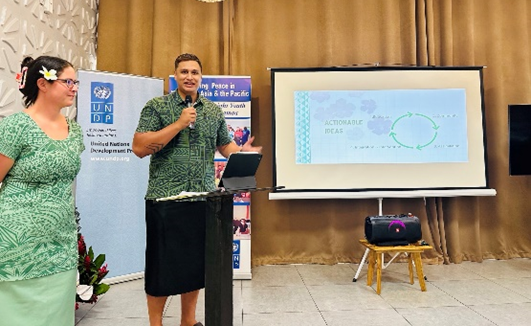Strategic foresight — a structured and systematic way of using ideas about the future to better prepare for change — can be used in peacebuilding to anticipate issues and opportunities before they arise. In March, DPPA and UNDP organized a workshop applying the technique to environmental issues for 25 youth peacebuilders from the Pacific and Northeast Asia.

Youth from Samoa, Tonga, Kiribati, Vanuatu, Solomon Islands, Fiji, Niue, Cook Islands, as well as the Republic of Korea, Japan and China, co-organized the workshop. Gathering in Samoa, participants used strategic foresight tools to think about issues such as climate change, biodiversity loss, and sustainable development.
The young peacebuilders were able to establish cross-regional networks and engage in intergenerational policy discussions, while connecting global efforts like the Paris Agreement to regional frameworks, including the Pacific Islands Forum’s Boe Declaration (2018) and the 2050 Strategy for the Blue Pacific Continent.
Foresight and the future
Participants were encouraged to use foresight to consider various alternative versions of the future and describe elements they believed should be changed or retained in the current system.
Alesana Malo, a PhD student at the University of the South Pacific, said that thinking about the future was not new: “We do it every day when we think about our career, education, or even the next meal, and have been doing it for generations. Strategic foresight is simply a way of system thinking to perceive events of the future: Potential events that can happen, events that are more likely to happen, and finally preferred events.”
Aloma Black, a youth environmentalist and conservationist from Samoa, highlighted that she “learned through the workshop that we share the same vision for our preferred future, but our pathways to get there differs because our contexts differ”.

The importance of traditional knowledge and local insights
During the training, the young peacebuilders also engaged in discussions with Government officials from the Samoan Ministry of Foreign Affairs and Trade, the Ministry of Natural Resources and Environment, the Ministry of Women, Community and Social Development and the Speaker of the Tongan Parliament, as well as UN staff. They highlighted that it was challenging to articulate the complexities of climate change because of the lack of relevant vocabulary in local languages. Participants also emphasized the relevance of traditional knowledge and proposed the establishment of a central repository for Pacific knowledge, to record and encourage the sharing of Pacific research, cultural values, and traditional knowledge.
Innovative technology was identified as a key factor, facilitating new approaches to foster accelerated green transitions and sustainable development. The youth examined the possibility of expanding the implementation of “smart grids” — an electrical grid that uses digital communications technology to detect and react to local changes in usage — to enhance energy resilience in Pacific communities.
Peter Due, Director of the Asia and the Pacific Division in DPPA, said the workshop contributed to “building peer-to-peer networks and empowering youth leadership and engagement in both regions on pressing issues globally but also regionally”.
Looking forward
Despite already feeling the impact of sea-level rise, extreme weather events, and other evidence of climate change, many remained hopeful that Pacific Islanders would be thriving in their home countries in the future, and one participant, Aloma Black, shared a particularly vivid description of her preferred future: She would like to hear the Manumea — a Samoan bird currently listed as endangered — sing again.

United Nations Resident Coordinator Themba Kaula highlighted that “Young people are not just beneficiaries of development agendas. They are active agents of change, catalysts for progress, and architects of peace and justice”.
Civic and political space for youth
With that in mind, participants emphasized the need for more dedicated spaces for meaningful youth participation. Among the points made by participants were that Pacific governments should include youth in government decision-making processes, such as Parliamentarian mentorship programs and paid internships; create Youth Councils; and support young negotiators as part of government delegations to international, regional, and national fora such as the UNFCCC Conference of the Parties (COP).
Nicc Moeano, a PhD student from Samoa at the University of Waikato, stressed that “one of the main things that I learned is that there are no limits for youth to be involved — they can participate in parliaments, they can participate in decision-making processes”. Adding to this, Aloma Black expressed hope that youth at the workshop would “take what they had learned and share it with other youth in their networks” and be “empowered to continue engaging in this work not only at the advocacy level but on the ground with rural youth as well”.
After the workshop the young peacebuilders produced a “Call to Action” containing that will be brought to relevant regional and global stakeholders at events such as COP29, Commonwealth Heads of Government Meeting CHOGM, the 4th International Small Island Developing States (SIDS) Conference, the Summit of the Future, and other major events. Malo said the youth will “put forward our actionable ideas to Parliamentarians and leaders in the Pacific as well as the whole world, for them to hear our voice and to do something about the impacts of climate change on us — the younger generation and future generations to come”.


